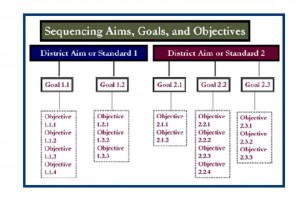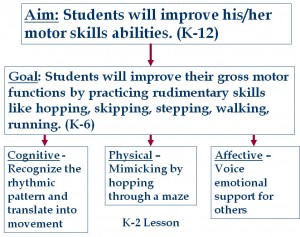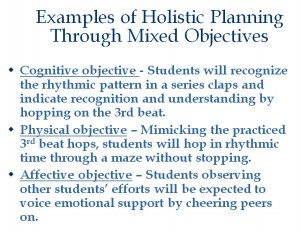The Aims, Goals, and Objectives – What are the differences for writing curriculum?
© Leslie Owen Wilson (1990, 1997, 2003, 2014, PDF File Below – all rights reserved)
Writing curriculum can be confusing. So what are the basic differences between these components referred to as aims, goals and objectives? A.G.O. is not only an easy acronym, it is an easy way to remember the correct progression from larger ideas to smaller instructional components. In everyday English we tend to use these terms interchangeably. Within the educational lexicon of curriculum development, for the past 3 decades scores of curriculum scholars, planners and administrators have been trying to standardize terms so that they refer to very specific curricular components. The following definitions are broadly accepted by groups trying to standardize terms for writing curriculum. They are also attempting to standardize these terms so that they are not confusing to readers and users. (It might be helpful to remember the acronym AGO in order to get the sequence straight.)
Schematically the process for writing curriculum can look like this:
Click diagram to enlarge
| Definition | Examples – These are intended to be a bit extreme, but perhaps you will get the points. | |
| Aims | Aims are general statements that provide direction or intent to educational action. Aims are usually written in amorphous terms using words like: learn, know, understand, appreciate, and these are not directly measurable. Aims may serve as organizing principles of educational direction for more than one grade. Indeed these organizing principles may encompass the continuum of educational direction for entire programs, subject areas or the district. | Students will understand and become proficient at identifying the different types of spoken English. |
| Goals | Goals are statements of educational intention which are more specific than aims. Goals too may encompass an entire program, subject area, or multiple grade levels. They may be in either amorphous language or in more specific behavioral terms. | Students will be able to identify and use American slang terms and phrases.(This example is a subset of the aim above, but the area becomes more specific. This goal moves from generic spoken English to the more detailed area of American slang. One verb used is still “identify,” although this goal does not specify how students are to identify, and the verb “use” has been added. The objectives related to this goal should specify how the students will identify and use new knowledge.) |
| Objectives | Objectives are usually specific statements of educational intention which delineate either general or specific outcomes.There are advantages and disadvantages to different types of objectives. · Behavioral objectives · Holistic objectives · Nonbehavioral objectives · Problem solving objectives · Expressive activities that lead to expressive outcomes. All of the above are legitimate ways to write curriculum and lesson plans. However, currently, most objectives are written in behavioral terms. Behavioral objectives usually employ observable verbiage and can be divided into specific domains — cognitive (head), affective (heart), and physical (hand) *Note: The examples to the right are meant to be a bit silly intentionally as to help my students remember them. Of course I would not do this in a classroom, although I am sure students would think it rather fun! | Objectives can be written in a number of ways. Currently, most objectives are written in behavioral terms. Behavioral objectives usually employ observable verbiage and can be divided into specific domains — cognitive (head), affective (heart), and physical (hand). Samples: · Cognitive: Students will identify and list 5 slang terms they have heard from their peers. · Affective: Student will choose 3 of the most offensive slang terms from a list developed by the entire class. · Physical: Students will create expressive gestures to go with their favorite slang terms. |
Other examples of how AGO can be used in planning using ALL 3 DOMAINS!
AGO Process showing aims, goals, and objectives
Click to here to view a larger version
You can download the AGO2 PPT. When viewing this PPT please note that instruction was set up so that all three domains were represented. This is an example how instruction can be set up so that it is more holistic.
Samples of Holistic Lesson Plans using all 3 Traditional Domains
The following plans were created by my undergraduate students between 2002-2008 incorporating all three domains. Even if they are not in a subject area you are interested in, the formats can serve as a prototype.
Other sample plans:
If you are curious how the AGO process might look in other types of lesson plans, over the years my students were kind enough to let me post samples of their plans as prototypes. While these are older submissions, they still illustrate the AGO principles quite well and the plans use a number of different instructional models — Hunter, Multiple Intelligence, Learning Styles, Problem Solving, Jigsaw etc. See this index for links to the plan samples.
Writing Curriculum Using Behavioral Objectives
These types of objectives are the majority of ones used in creating today’s lesson plans, and they usually specify behaviors students must demonstrate to indicate that learning has occurred. Please note that while mastering this form of lesson planning is essential to professional educators, these are not the only types of objectives that can occur in developing curriculum. Very proficient and artistic teachers can use problem solving objectives, as well as expressive activities that lead to expressive outcomes. These are explained in the instructional design section more fully.
Advantages of behavioral objectives:
- They are easy to write.
- They are easier to categorize by domain (cognitive, affective, physical/kinesthetic/tactile).
- They are more easily evaluated. (usually, by objective methods.)
- May easily be designated for horizontal enrichment or vertical acceleration into categories of:
- must know
- need to know
- nice to know
- or alternative categories like: introduced, developed, mastered.
See pages on Creating more personalized educational pathways through prioritized objectives.
To reiterate through my unusual examples. Using the aforementioned district aim and goal concerning the understanding and development of spoken English proficiency, here are three examples of behavioral objectives in all three domains: (and yes, the examples are meant to be a bit bizarre.) The progression would look like this:
Examples:
Aim: Students will understand and become proficient at identifying the different types of spoken English.
Goal: Students will be able to identify and use American slang terms and phrases
Cognitive: Students will identify and list 5 slang terms they have heard from their peers.
Affective: Student will choose 3 of the most offensive slang terms from a list developed by the entire class.
Physical: Students will create expressive gestures to go with their favorite slang terms.
Please note that in two of the objectives, specific evaluation criteria have been built in. This is one of the strengths of behavioral objectives.
The advantage to creating more holistic objectives (ones that fall into more than one domain) is that this process creates additional neural pathways which help in recall. This allows learners to more easily remember material and processes. In the past there has been an over dependence on writing just cognitive objectives. It will be easier to develop holistic objectives in some areas of study over others. For instance, some educators find it hard to form affective objectives in the area of math. While this may be true, it is imperative for educators not to intentionally ignore instances where an array of domains can be included in lessons.
For more information on behavioral objectives, go to the original sources:
(As these hotlinks take readers to Amazon, the FTC requires me to indicate that they qualify as ads)
Updated version of Bloom’s) Anderson, L. W. and Krathwohl, D. R., et al (Eds..) (2001) A Taxonomy for Learning, Teaching, and Assessing: A Revision of Bloom’s Taxonomy of Educational Objectives. Allyn & Bacon. Boston, MA (Pearson Education Group) **There is a newer (2013), abridged, less expensive version of this work. #ad
Bloom, B.S. and Krathwohl, D. R. (1956) Taxonomy of Educational Objectives: The Classification of Educational Goals, by a committee of college and university examiners. Handbook I: Cognitive Domain. NY, NY: Longmans, Green.
Krathwohl, D. R. (2002) A Revision of Bloom’s Taxonomy. (PDF) in Theory into Practice. V 41. #4. Autumn, 2002. Ohio State University. Retrieved @ https://www.depauw.edu/files/resources/krathwohl.pdf
Krathwohl, D.R., Bloom,B.S. and Masia, B. B. (1964).Taxonomy of educational objectives, Book II. Affective domain. New York, NY. David McKay Company, Inc.
**Newer Pages
- **New: Taxonomies of Learning – A comprehensive listing of the 3 traditional domains of learning, plus additions in the psychomotor domain, and examples of newer taxonomies.
- The Flipped Classroom
- Madeline Hunter Lesson Plan (includes formatted sample lesson)
- Making Instructional Decisions – A guide for both novice and veteran teachers and
- A dozen important brain based learning concepts – Things every teacher (and parent) should know
- Writing Good Curriculum – What makes a curriculum really usable?
Giving = Continued Sharing
I created the Second Principle to share information about the educational ideas at the heart of all good teaching. I am dedicated to the ideal that most of materials on this site remain free to individuals, and free of advertising. If you have found value in the information offered here, please consider becoming a patron through a PayPal donation to help defray hosting and operating costs. Thanks for your consideration, and blessings on your own journey.



